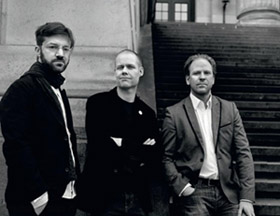 It isn’t your grandfather’s Vivaldi. But echoes of the baroque original are always near enough for even the most die-hard purists to marvel at Max Richter’s reinvention of that classic chestnut, The Four Seasons.
It isn’t your grandfather’s Vivaldi. But echoes of the baroque original are always near enough for even the most die-hard purists to marvel at Max Richter’s reinvention of that classic chestnut, The Four Seasons.
Recomposed by Max Richter is the latest in a series developed by the record label Deutsche Grammophon that features modern interpretations of classical music by contemporary artists. (The last release was a reworking of Mahler’s so-called Tenth Symphony, by Matthew Herbert.) For The Four Seasons, one of the most popular works in the classical canon, DG chose the 46-year-old British-trained musician, whose background, seeped in the sensibilities of such minimalists as Philip Glass, Steve Reich, and Arvo Pärt, as well as an affinity for the electronic genre, boded well for a drastic dusting-off of the old standard.
Of course, the challenges posed by such a project are obvious. There’s a fine line when tackling the tricky work of tinkering with pieces that are the stuff of history and have thrived intact through the ages. But Richter proves himself more than up to the task.
 Listeners are put on immediate notice that they’re in for something quite different at the very start of the piece, with a 30-second sonic “dubby cloud” as Richter describes it, that “functions as a sort of prelude, setting up an electronic ambient space for the first ‘Spring’ movement to step into.” The section’s joyous and anticipatory opening strains are far from anything recognizable in the original, but suddenly, from around the corner, you’ll be hit with a blast from the 18th-Century past that’s signature Vivaldi. It’s an ingenious navigation that surprises at every turn.
Listeners are put on immediate notice that they’re in for something quite different at the very start of the piece, with a 30-second sonic “dubby cloud” as Richter describes it, that “functions as a sort of prelude, setting up an electronic ambient space for the first ‘Spring’ movement to step into.” The section’s joyous and anticipatory opening strains are far from anything recognizable in the original, but suddenly, from around the corner, you’ll be hit with a blast from the 18th-Century past that’s signature Vivaldi. It’s an ingenious navigation that surprises at every turn.
As is also the case with ”Summer,” and its third-section “storm,” which pulses with an urgency that shifts in and out of connections to its predecessor, ending with an eerie descent into calmness, accompanied by a progression of enigmatic knocking sounds in the distance. The aurally mesmerizing second movement of “Autumn” is made memorable by the electronic harpsichord of Raphael Alpermann, while the stunning “Winter” section, with its sharp pizzicatos of the first movement, are a showcase for violinist Daniel Hope, who also displays a softer side to his playing, concluding “Winter” — and the Seasons — with an air of contemplation.
In the liner comments for Recomposed, Richter says that he “wanted to get inside the score at the level of the notes and in essence re-write it, re-composing it in a literal way.”
His magnificent melding of past and present shows again that great works of art are organic things, which, in respectful hands, can be reshaped into something fresh and wondrous and altogether new. I have a feeling Vivaldi himself would be pleased with the result.


Wonderful review!